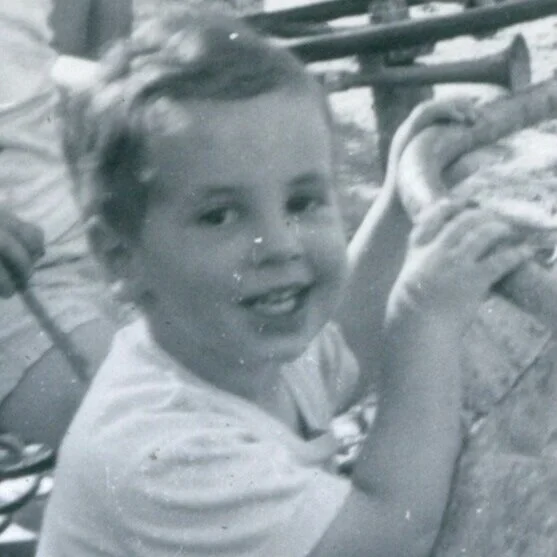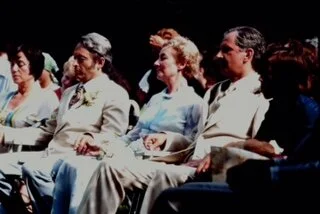Judith Saly—A Hundred Years of Kindness
Judith Saly at 99
Today’s newsletter is written in honor of an exceptional woman, Judith Saly, who turns 100 tomorrow. Judith is my first friend to have lived for an entire century, and I’m eager to share some of her life story and valuable wisdom with you.
I met Judith in 1970. I was six years old, and my parents had just joined a New Age community called The Pathwork. The organization’s foundational teachings came from the Guide—a spirit channeled by an Austrian-born medium, Eva Pierrakos. The Pathwork, and its thriving residential center in the Catskills, were the focal point of my family’s life until I was thirteen.
Despite my family’s abrupt and extremely painful departure from The Pathwork, those seven years, albeit far from perfect, were pivotal in my father’s healing journey. Although my parents never reconnected with former Pathwork friends after we left, they had been very close to Judith, and Judith never lost her affection for them.
In 2011, after thirty-five years, I reconnected with Judith’s daughter, Camilla, thanks to my sister who organized a “Pathwork kids’ reunion” in California. Camilla and I became fast friends, and I was affectionately embraced by Judith and her two other children, Alan and Silver. I began to spend time with Judith and her family when I was in New York City.
Judith, who is Hungarian like my mother, taught my daughter Marea and me how to cook the dishes that she and my mother had grown up enjoying. Marea and I attended Camilla’s wedding, where 93-year-old Judith and the mother of the groom were enchanting flower girls. Soon after, the Saly’s (all of them writers) helped tremendously with the Pathwork chapters in Quest for Eternal Sunshine, providing both memories and corrections.
Judith’s Journey
Getting to know Judith has been a huge gift and pleasure. She is one of the most intelligent, open-minded, and open-hearted people I have ever known. Just being in her presence feels rich and calming, so I was surprised to learn how much trauma she’s endured.
Judith at age three, with her grandmother, Camilla Beck
Born in Budapest in 1921, to a loving family that was Jewish, but not observant, Judith was the eldest of two daughters. She was twenty-three in March of 1944, when Nazi forces occupied her city. In May, deportations began, and in just eight weeks, 424,000 Jews were sent to Auschwitz-Birkenau, the vast majority of whom were gassed upon arrival. Judith managed to survive the terror of the Holocaust in hiding, mostly due to the bravery and determination of a non-Jewish astronomer and physicist named John Kudar—a man who proposed after knowing her for only one day, with the promise of doing everything he could to save her life.
“John acquired false papers that let me escape from being registered as a Jew, and quickly secured us a room in a building at an observatory that belonged to the University of Budapest. When we heard about the Swedish diplomat Raoul Wallenberg’s efforts to protect thousands of Jews from deportation on the BBC, John went to Wallenberg to offer his assistance. Soon John was working with Wallenberg every day, and I always accompanied him. Wallenberg managed to put some apartment buildings under the protection of the Swedish crown, and he arranged for my parents and sister to move there, which saved their lives. I was very lucky, but many of my beloved uncles, aunts, and cousins were deported. Most never returned.”
When the Soviet forces liberated Budapest in February 1945, Judith and her husband escaped Hungary by making their way to British-occupied Greece and then getting passage on a plane to London. After five years, they immigrated to America. Once settled in New York, Judith began working at the Voice of America as a Hungarian and English typist. “I was so proud to be able to pay taxes that helped America build bridges and roads. Perhaps I was the only person in the whole country who actually liked to pay taxes!”
Despite their great affection for one another, Judith and John divorced in 1953. Two years later, Judith fell in love with and married a fellow Hungarian immigrant—a Catholic man who was studying for his Ph.D. in English Literature, who happened to also be named John. Their first child, Alan, was born in 1956, followed fourteen months later by a second son, Christi. When Judith’s third child, Camilla, was a baby and she was newly pregnant with Silver, Judith endured the most unbearable heartbreak any parent can face. At three years old, Christi was outside playing with some other children while Judith was inside with her newborn. Just a few feet from the house, construction workers had left a burning pot of tar unattended. When Christi brushed into it, his clothes caught on fire. He ran home to Judith, who doused the flames and called for an ambulance, but Christi passed away three days later.
Judith, with her first husband, John Kudar, in 1946
Christi at 3
Judith with Alan, Camilla and Silver, upstate NY, circa 1961
The Pathwork
Though her grief was almost impossible to bear, Judith had her other children to care for, and the teachings from the Guide, which she had discovered a few years before the tragedy, helped her cope.
“I was always looking for the meaning of life. Because we’d been so assimilated growing up, I had little connection to the Jewish tradition. I tried to be Catholic, but there were many things that I could not accept. Nothing fit until I read a transcript of one of the Guide’s lectures. The teachings, both spiritual and psychological, were just what John and I were looking for. The Guide said to only take what you resonate with, which I greatly appreciated, but I resonated with everything. I knew I had finally found my path.”
When Judith and John went to their first live lecture in 1957, they met the medium, Eva, on the ground floor while waiting for the elevator. “I’d imagined someone who communicated with a spirit would look pale and gaunt, so I was surprised that she looked mundane, just a nicely dressed woman wearing a lot of makeup.” There were about thirty other people in attendance that evening, most of them immigrants from Austria or Germany. “Eva sat in a straight-backed chair with background music playing, candles and incense burning. Soon she took a few deep breaths, sort of fell a bit forward, and when she straightened she was in a trance and the Guide began to speak through her. I’d never believed in things like that before, but it really seemed authentic.”
Myra’s parents, Edith and Mendek Rubin (far left) with Judith and John Saly at a Pathwork marriage vow renewal ceremony, mid-1970s
In the early days, Eva gave private Guide sessions to her followers, but by the early 1970s, the organization had grown far too large for that. A small number of leading members were trained by Eva and her husband to be “Helpers,” including Judith, her husband, and both of my parents. Helpers taught newer members the Pathwork philosophy, provided therapeutic counseling, and ran group therapy sessions. Members of “Training Group One” were the top tier of the organization. My parents were the only people from that core group to ever become disillusioned and leave the Pathwork while Eva was alive, and it caused an ugly upheaval.
Long after Eva’s death in 1979, Judith continued to be a pillar of the more decentralized Pathwork organization. She edited and wrote the introduction to the first book of Lectures, “The Pathwork of Self-Transformation,” which came out in 1984, and was then republished by Bantam Books in 1990. The book did so well it was translated into German, French, Spanish, Portuguese, and Hebrew, which brought the Guide’s teachings to people all over the world.
In 1992, Judith’s husband had a series of strokes and died four years later. Today, Judith continues to live in their apartment on the upper west side of Manhattan with her daughter Silver, who helps care for her, along with Camilla and Alan. Remarkably, Judith’s mind is as sharp and clear as ever, but she is legally blind and has needed help dressing and bathing since she broke her hip earlier this year.
A Life of Love
Judith says the biggest lessons she’s learned in her long life, filled with so much beauty and pain, is to let go of judging others and instead to turn towards love. “What’s most important is what we do in the here and now. When I was younger, I’d always wanted to know the reason behind everything, especially why I was here on earth. But then I realized that I can’t know it all, and that it’s actually okay. Every day I just do my best and learn to let go of much of what I have been attached to. Right now, what is most important for me is that I love so many people and that I feel a lot of love coming towards me.”
Judith (far right) with her best Hungarian friends in Manhattan, circa 1963
Honesty and gratitude are pillars of Judith’s life. “I am very grateful for all the good things that have happened to me. Every day I appreciate that I have everything I need at this moment. I also see my limitations. I accept my humanity, and therefore my imperfections. And I accept that soon I am going to die.”
Asked if she has a belief about what will happen when her time comes, Judith replied, “It’s impossible to know for sure, but I somehow have the sense that one doesn’t totally disappear into nothingness. I believe there is a spirit world, but I have no idea what happens there.” Judith has always loved and greatly respected the work of Johann Wolfgang von Goethe, who had a firm belief that spirits are indestructible and that nothing goes to waste in nature. “It’s difficult to imagine that all that one learns and develops in one’s lifetime simply disappears. I believe Goethe. How can all this be for nothing?”
Years ago, Judith told me that the most profound piece of wisdom she’s acquired in her long life is something she read on a teabag long ago: “When in doubt, do what is kindest.” I have taken this to heart, using it to inform my decisions over and over again in many different situations. Each time I do, I think of Judith, and send love her way. It’s wonderful to know that she feels it.
Happy 100th Birthday Judith.
Thank you for making this world a kinder and more beautiful place!








